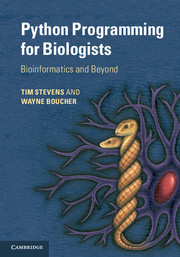Python Programming for Biology Bioinformatics and Beyond
Langue : Anglais
Auteurs : Stevens Tim J., Boucher Wayne

This book introduces Python as a powerful tool for the investigation of problems in computational biology, for novices and experienced programmers alike.
Do you have a biological question that could be readily answered by computational techniques, but little experience in programming? Do you want to learn more about the core techniques used in computational biology and bioinformatics? Written in an accessible style, this guide provides a foundation for both newcomers to computer programming and those interested in learning more about computational biology. The chapters guide the reader through: a complete beginners' course to programming in Python, with an introduction to computing jargon; descriptions of core bioinformatics methods with working Python examples; scientific computing techniques, including image analysis, statistics and machine learning. This book also functions as a language reference written in straightforward English, covering the most common Python language elements and a glossary of computing and biological terms. This title will teach undergraduates, postgraduates and professionals working in the life sciences how to program with Python, a powerful, flexible and easy-to-use language.
Preface; Acknowledgements; 1. Prologue; 2. Beginners' guide; 3. Python basics; 4. Program control and logic; 5. Functions; 6. Files; 7. Object orientation; 8. Object data modelling; 9. Mathematics; 10. Coding tips; 11. Biological sequences; 12. Pairwise sequence alignments; 13. Multiple sequence alignments; 14. Sequence variation and evolution; 15. Macromolecular structures; 16. Array data; 17. High-throughput sequence analyses; 18. Images; 19. Signal processing; 20. Databases; 21. Probability; 22. Statistics; 23. Clustering and discrimination; 24. Machine learning; 25. Hard problems; 26. Graphical interfaces; 27. Improving speed; Appendix 1: simplified language reference; Appendix 2: selected standard type methods and operations; Appendix 3: standard module highlights; Appendix 4: string formatting; Appendix 5: regular expressions; Appendix 6: further statistics; Glossary; Index.
Tim Stevens is Senior Investigator Scientist at the MRC Laboratory of Molecular Biology in Cambridge. He researches single-cell 3D genome architecture and provides computational biology oversight, development and training within the Cell Biology Division.
Wayne Boucher, a mathematician and theoretical physicist by training, is a senior postdoctoral associate and computing technician for the Department of Biochemistry at the University of Cambridge. He teaches undergraduate mathematics and postgraduate programming courses, and is currently developing software for the analysis of biological molecules by nuclear magnetic resonance spectroscopy.
Wayne Boucher, a mathematician and theoretical physicist by training, is a senior postdoctoral associate and computing technician for the Department of Biochemistry at the University of Cambridge. He teaches undergraduate mathematics and postgraduate programming courses, and is currently developing software for the analysis of biological molecules by nuclear magnetic resonance spectroscopy.
Date de parution : 02-2015
Ouvrage de 711 p.
18.2x25.3 cm
Disponible chez l'éditeur (délai d'approvisionnement : 14 jours).
Prix indicatif 134,74 €
Ajouter au panierDate de parution : 02-2015
Ouvrage de 711 p.
17.6x24.7 cm
Disponible chez l'éditeur (délai d'approvisionnement : 14 jours).
Prix indicatif 64,97 €
Ajouter au panierThème de Python Programming for Biology :
© 2024 LAVOISIER S.A.S.
